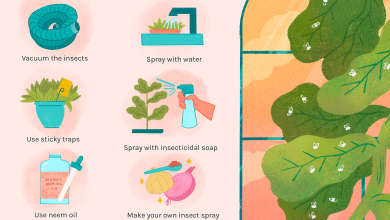Rotten fruits, with spots, holes or lumps: Damage to fruits
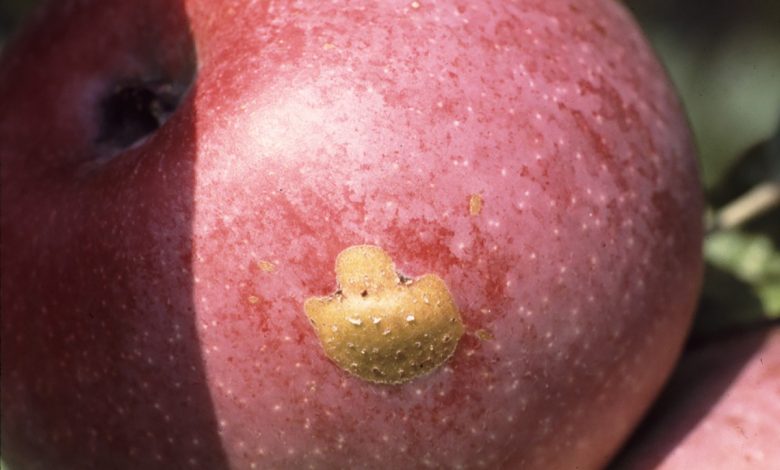
Hello to all agrohuerters! In today’s article we are going to learn how to detect damage to fruits in our orchard and identify their causes.
First of all I would like to clarify what the term “fruit” refers to. The fruit is a word that is used in botany to refer to the organ of the plant that comes from the flowers and inside which the seeds are found. These fruits, depending on the plant, can have different shapes, colors, textures and sizes.

Within the world of food, the best known fruits are fleshy fruits, legumes, nuts or grain fruits such as corn. Therefore, the next time someone asks you if the tomato is a fruit or a vegetable, you can answer that it is a fruit and you will never fail.
Types of fruit damage: rotten fruit, lumps, spots…
As soon as we observe the fruits of the orchard we will see that, sometimes, these fruits can be damaged. They can have spots, mosaics, deformed fruits, be rotten, have holes or lumps, etc. Therefore, we will try to examine each of these symptoms.
A hailstorm can also cause damage to the fruit and, consequently, facilitate the subsequent attack of fungi.
Below I present different symptoms of fruit damage.
fruit with holes
Undoubtedly, the main culprits that have holes in our fruits and small galleries are the caterpillars or larvae. Most of the time the adults lay their eggs inside the fruit. There, the larvae will develop and later they will go outside creating a small hole. Sometimes, they can eat the inside of the fruit causing it to rot.
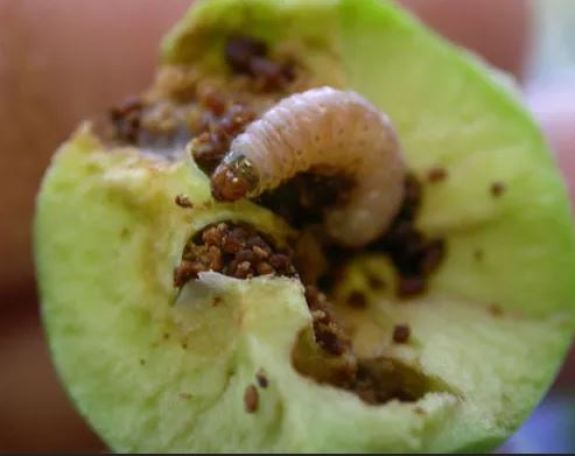
The best known caterpillars that damage the fruits are:
- Apple codling (Cydia pomonella)
- Tomato moth (Tuta Absoluta)
- Ceratitis capitata
- Drosophila melanogaster (attacks apples, grapes, bananas, etc.)
- Drosophila suzukii (has a preference for red and soft summer fruits such as strawberries, peaches, plums, blackberries, cherries, etc.)
- Olive fruit fly (Bactrocera oleae)
Fruit end rotten or with black spot («rotten asses in the tomato»)
The problem of rotten asses occurs mainly in tomatoes or other vegetables and is due to a lack of calcium or water stress (lack of moisture).
It begins with a loss of color from the bottom of the tomato, regardless of its size as it affects both large and small. The skin then depresses, contracts, and eventually softens, changing its hue to a dark brown almost black.
The solution is very easy in the case of vegetables. In short, it is enough to adjust the irrigation doses (increase the dose or the frequency if you have hydric stress) or incorporate some eggshells into the soil. In this article that Álvaro wrote about how to solve the problem of rotten ass in tomato you will find more information and this video in which he told us about his experience.
Gray spots with hairs
If we find stains of these characteristics, it is most likely a fungus called Botrytis. Forms gray and hairy rots. This fungus spreads with mild temperatures, high humidity and little ventilation. Among the main fruits affected are: strawberries, grapevines,
White powder on the surface of the fruit
White powder is the most characteristic symptom of Oidium, a very typical fungus in our garden.
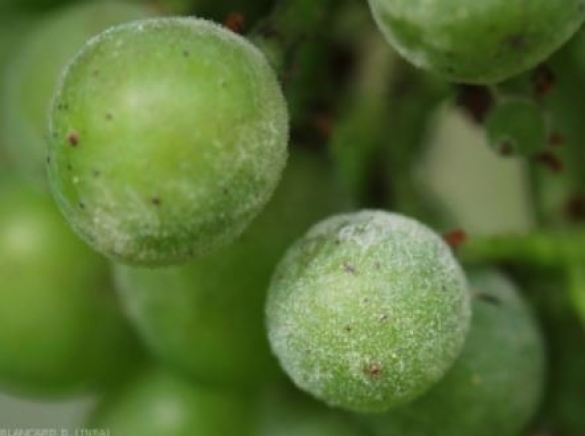
Circular white spots on fruit
These types of stains are usually due to the presence of a virus. For example, the Sharka (Plum Pox virus). In addition, they can cause deformations or small lumps in the fruits. This virus is transmitted by aphids.
In addition, there is a disease caused by a fungus known as Monilia that mainly affects plums, apricots, peaches, pears, etc. It creates concentric white circles on the fruit and over time the fruit ends up mummified.

If we find stains of these characteristics, it is most likely a fungus called Botrytis. Forms gray and hairy rots. This fungus spreads with mild temperatures, high humidity and little ventilation. Among the main fruits affected are: strawberries, vines, lettuce, cucumber or solanaceous plants such as tomato or eggplant.
Scattered brown or black spots
There are several causes that cause brown or black spots of different sizes on the fruits. However, Mildew is one of the main fungi responsible for causing these types of stains.
In the case of the apple tree, there is a disease known as Apple Scab or Scab (Fungus: Venturia inaequalis) whose symptoms are scattered black spots on the surface of the apple as seen in the photo.
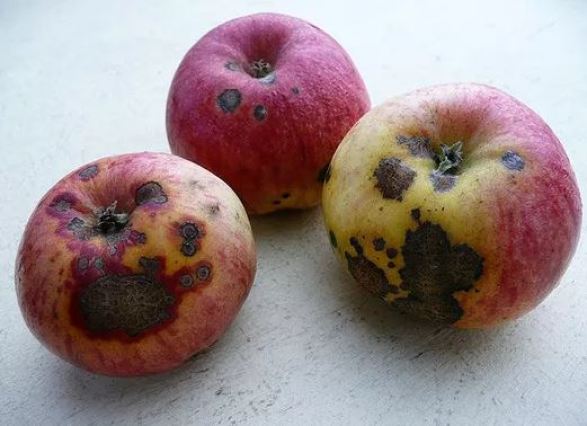
If, on the other hand, we see small and scattered black dots on our apples, it is due to a nutritional imbalance (usually a lack of calcium) and is known as Bitter Pit.
Lumps in the fruits
As we have mentioned before, some types of virus (Example: Sharka) can cause fruit damage and deformation. These deformations make the fruits unmarketable.
Do not be confused with the natural deformations of the fruits. And remember, that although the fruits do not have the perfect shape, they are still just as rich and therefore they should not be wasted.
References
- Braun, U. (1980).Morphological Studies in the Genus Oidium. Flora. 170(1–2), 77-90.
- G. KALLOO. (1993).Tomato: Lycopersicon esculentum Miller. Editor(s): G. KALLOO, BO BERGH. Genetic Improvement of Vegetable Crops, Pergamon, 645-666.
- Erba, D., Casiraghi, C., Agustí, A., Cáceres, R., Marfà, O., Castellari, M. (2013).Nutritional value of tomatoes (Solanum lycopersicum L.) grown in greenhouse by different agronomic techniques. Journal of Food Composition and Analysis, 31(2), 245-251
If you have problems with fungi, I leave you here a link of homemade fungicides. And if the problem is the spots on the leaves, you can also consult: brown spots on the leaves and white spots on the leaves.
See you in the next article!

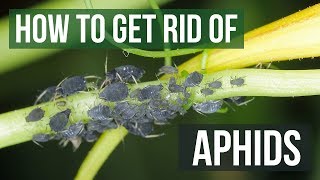

![Photo of Trasdescantia Zebrina: [Cultivation, Care, Pests and Diseases]](https://www.complete-gardening.com/wp-content/uploads/2022/08/trasdescantia-zebrina-cultivation-care-pests-and-diseases-390x220.jpg)
